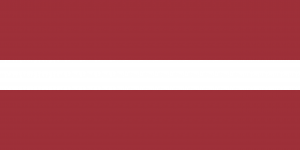Language/Standard-latvian/Vocabulary/Greetings-and-introductions
| ◀️ Adjectives and their agreement with nouns — Previous Lesson | Next Lesson — Numbers and time ▶️ |
Introduction: Greetings and introductions are an essential part of daily life and routines in any language. It is through these interactions that we establish connections, show respect, and create a sense of community. In the Latvian language, greetings and introductions play a significant role in social interactions. In this lesson, we will learn how to introduce ourselves and greet people in Latvian, providing you with the necessary vocabulary and phrases to navigate social situations with confidence.
Structure of the Lesson: 1. Basic Greetings 2. Introducing Yourself 3. Formal and Informal Greetings 4. Cultural Insights and Interesting Facts 5. Practice Exercises
Basic Greetings[edit | edit source]
Let's start by learning some basic greetings in Latvian. These greetings are commonly used in various social situations and can be used at any time of the day.
| Standard Latvian | Pronunciation | English Translation |
|---|---|---|
| Sveiki! | [svei-ki] | Hello! |
| Labdien! | [lab-dien] | Good day! |
| Labrīt! | [lab-ri:t] | Good morning! |
| Labvakar! | [lab-va-kar] | Good evening! |
| Uz redzēšanos! | [uz red-ze:-sha-nos] | Goodbye! |
Introducing Yourself[edit | edit source]
When meeting new people, it is important to be able to introduce yourself. Here are some phrases that will help you introduce yourself in Latvian:
- Mani sauc [Your Name]. (My name is [Your Name].) - Es esmu no [Your Country]. (I am from [Your Country].) - Es mācos [Your Occupation/Field of Study]. (I am studying [Your Occupation/Field of Study].) - Es strādāju par [Your Occupation]. (I work as a [Your Occupation].)
For example: - Mani sauc Anna. Es esmu no Amerikas Savienotajām Valstīm. Es mācos medicīnu. (My name is Anna. I am from the United States. I am studying medicine.) - Mani sauc Jānis. Es strādāju par programmētāju. (My name is Jānis. I work as a programmer.)
Remember to adjust the phrases according to your own name, country, occupation, or field of study.
Formal and Informal Greetings[edit | edit source]
In Latvian culture, it is important to distinguish between formal and informal greetings, depending on the level of familiarity or respect towards the person you are addressing. Let's explore some examples:
1. Formal Greetings: - Labdien, kungs! (Good day, sir!) - Labdien, kundze! (Good day, madam!) - Labdien, profesore! (Good day, professor!)
2. Informal Greetings: - Sveiks! (Hello!) - Sveika! (Hello!)
It is customary to use formal greetings when addressing someone older, in a position of authority, or whom you have just met for the first time. Informal greetings are used among friends, peers, or in more casual settings.
Cultural Insights and Interesting Facts[edit | edit source]
Latvian culture places great importance on greetings and introductions. It is considered polite and respectful to greet someone when entering a room or starting a conversation. Handshakes are the most common form of greeting, especially in formal situations. When greeting someone, it is customary to make direct eye contact and smile.
In Latvian culture, it is also common to exchange pleasantries and inquire about the other person's well-being. Asking "Kā jums klājas?" (How are you?) or "Kā jums iet?" (How is it going for you?) shows genuine interest in the other person's welfare.
Furthermore, Latvians typically address each other by their first names, followed by their patronymic name (derived from their father's first name). For example, Jānis Bērziņš would be addressed as Jāni Bērziņ. Using the person's first name alone may be perceived as overly familiar, especially in formal settings.
Practice Exercises[edit | edit source]
Now let's put your knowledge to the test with some practice exercises. Translate the following greetings and introductions from English to Latvian:
1. Hello! 2. Good morning! 3. My name is John. I am from Canada. 4. What is your name? 5. How are you? 6. Goodbye!
Solutions: 1. Sveiki! 2. Labrīt! 3. Mani sauc Džons. Es esmu no Kanādas. 4. Kā jūs sauc? 5. Kā jums klājas? 6. Uz redzēšanos!
Explanation: 1. The Latvian translation for "Hello!" is "Sveiki!". 2. "Good morning!" is translated as "Labrīt!". 3. "My name is John. I am from Canada." is translated as "Mani sauc Džons. Es esmu no Kanādas." 4. "What is your name?" is translated as "Kā jūs sauc?" when addressing someone formally. 5. "How are you?" is translated as "Kā jums klājas?" when addressing someone formally. 6. "Goodbye!" is translated as "Uz redzēšanos!".
Remember to practice these phrases with a native Latvian speaker or your language exchange partner to improve your pronunciation and fluency.
Other Lessons[edit | edit source]
- Jobs and professions
- Drinks
- Colors
- Family
- Using public transport
- Education
- Clothes
- Free time activities and sports
- How to say Good Bye?
- Idiomatic Expressions
| ◀️ Adjectives and their agreement with nouns — Previous Lesson | Next Lesson — Numbers and time ▶️ |

